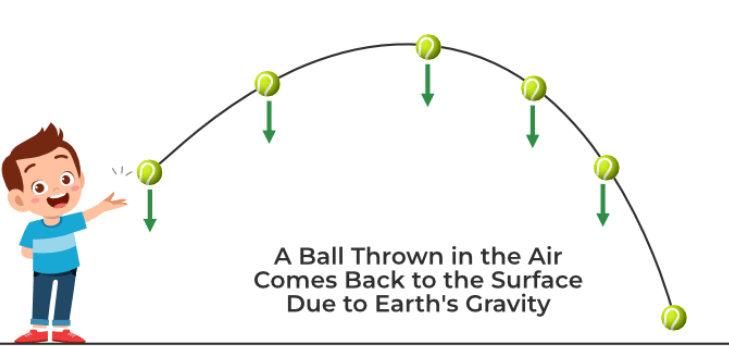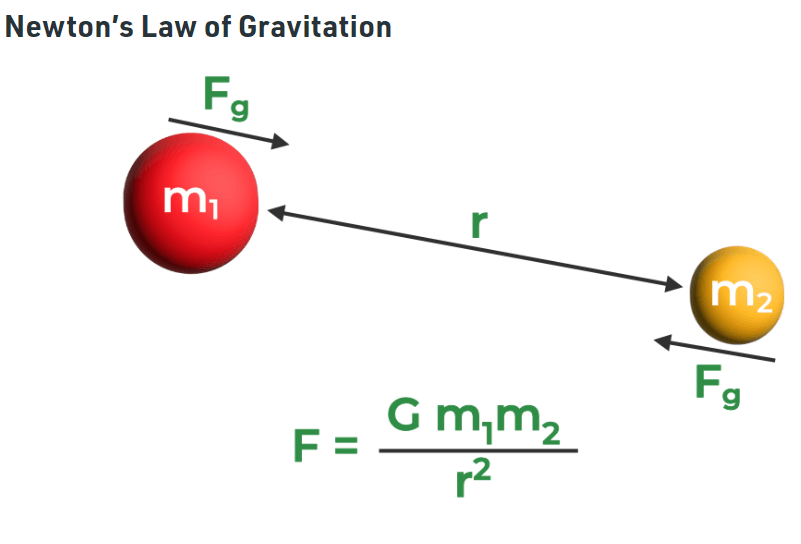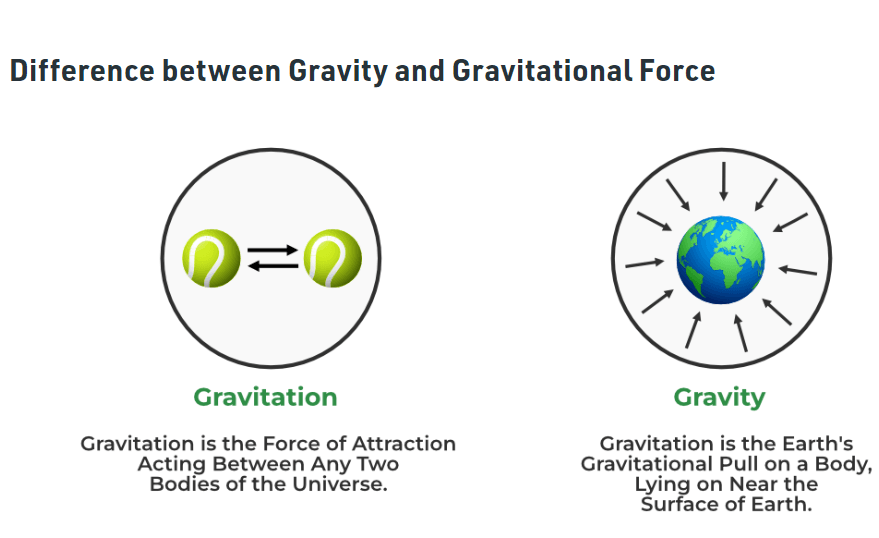Gravitational Force Definition
Newton's Law of Universal Gravitation describes how gravitational force works. A non-contact gravitational force is a continuous attracting and constrictive force in the natural world. When two or more objects come into contact, there is an attraction caused by gravitational force. The Gravitational Force Formula is derived from Newton's Universal Law of Attraction. Gravity surrounds our surroundings. What Does Gravity Mean?Whether the masses of two things are equal, the gravitational attraction will bring them together. The cosmos, including you, pulls everything else, according to Newton's Universal Law of Gravitation. The symbol for gravitational force is Newton or N. 
Numerous well-known scientists have made significant contributions to the study of gravitation. Galileo Galilei, an Italian astronomer, established that all objects accelerated evenly towards the center of the Earth at the beginning of the 17th century. English mathematician Isaac Newton discovered the initial discovery of gravitational laws in his groundbreaking paper from 1687. Since its effects on any item may easily be seen, gravity is regarded as a fundamental force. As a result, the gravitational force affects every mass-containing object. Hence, gravity qualifies as an elemental force. There is no physical contact between the things, so the gravitational force is non-contact. It is centripetal because it is concentrated at the axis of the object's angular orbit. Maintaining the body's orbit is its responsibility. The rotating body feels a drag from the side, away from the center. The centrifugal force brings on this pulling. The least powerful of the elemental forces is gravity. All things in the cosmos, regardless of mass, are always drawn to one another by a force of attraction, according to Newton's Law of Gravitation, sometimes referred to as Newton's Law of Universal Gravitation (or Universal Laws of Gravitation). The gravitational force, abbreviated as F, is the name for this pulling force.
Gravitational Force Unit
Gravitational Force Characteristics
Here are some crucial aspects of the gravitational force:
The gravitational force of Earth, sometimes known as gravity, affects everything. We cannot freely float in the air because of gravity, which keeps us on the ground. The forces acting on the globe are balanced between the Planet and humanity. But due to its enormous size, the Earth is unharmed. If a hanging object is released, it will fall naturally in the direction of the center of the Earth. Force of Gravitation Between the Earth and the MoonThe Moon circles the Earth because of the gravitational attraction of both bodies. We insert their masses and the distance between their two centers into the gravitational force formula to calculate this force. Then, it was discovered that the gravitational force between the Earth and the Moon was 2 1020 N. The Sun's Gravitational ForceThe Sun has a vast gravitational field because of its enormous mass. Due to this attractive force, all planets orbit the Sun in an elliptical pattern. 3.5 1022 N was found to be the gravitational force exerted by the Sun on Earth using the gravitational force formula. Gravity's Relationship to Gravitational ForceAs seen in the table below, there are some critical differences between gravity and the gravitational force that we should discuss in more detail: 
Scientific Upheaval:In the middle of the 16th century, European scientists scientifically refuted the Aristotelian idea that heavier objects fall more quickly. Mainly, creatures in free fall evenly accelerate, according to a 1551 essay by Spanish Dominican priest Domingo de Soto. Benedetto Varchi, Francesco Beato, Luca Ghini, and Giovan Bellaso, Dominican priests who disagreed with Aristotle's views regarding the fall of corpses, may have influenced De Soto's earlier studies in Italy. Italian physicist Giambattista Benedetti wrote papers in the middle of the 16th century asserting that objects composed of the same material but of different masses will fall at the same rate because of particular gravity. Simon Stevin, a Flemish physicist, discovered in 1586 through the Delft tower experiment that two cannonballs of different weights and sizes fell from a tower at the same velocity. Galileo Galilei conclusively proved that gravitational acceleration was the same in the late 16th century because of his meticulous measurements of balls falling down the incline. Galileo proposed that low-density, high-surface-area objects fall more slowly in an atmosphere due to air resistance. Galileo correctly predicted that a falling object's distance is related to the square of the time that has passed in 1604, and he was right. Italian Jesuit scientists Grimaldi and Riccioli later validated this between 1640 and 1650. They also measured a pendulum's oscillations to determine the strength of the Earth's gravity. Gravity, According to Newton
Isaac Newton provided Kepler's rules of planetary motion a scientific basis in his 1684 manuscript De motu corporum in gyrum ('On the Motion of Bodies in an Orbit'), which was sent to Edmond Halley. The paper struck a chord with Halley, who encouraged Newton to elaborate. A few years later, Newton released the groundbreaking work Philosophiae Naturalis Principia Mathematica (Mathematical Principles of Natural Philosophy). According to Newton, who referred to gravity in this book as an all-pervasive force, the forces that keep the planets in their orbits must [be] reciprocally proportional to the squares of their distances from the centers around which they rotate. Subsequently, this claim was condensed to the following statement using the inverse-square law: Where m1 and m2 are the interacting objects' respective masses, r is the distance between their mass centers, and G is the gravitational constant of 6.674 1011 m3 kg1 s2. The scientific community welcomed Newton's Principia, and his law of gravitation swiftly spread throughout Europe. When it was used to foresee the existence of Neptune more than a century later, in 1821, his theory of gravitation gained much greater notoriety. The French astronomer Alexis Bouvard employed this hypothesis to calculate Uranus' orbit that year, and it was discovered that the model significantly deviated from the Planet's accurate track. Many astronomers hypothesized that there might be a sizable object beyond Uranus' orbit that was causing its orbit to be disturbed to explain this disparity. Neptune was found there within a day after the astronomers John Couch Adams and Urbain Le Verrier utilized Newton's formula to forecast its location in the night sky in 1846. Quantum Mechanics and GravityGeneral relativity can accurately anticipate the effects of gravity at large scales, but it cannot reconcile quantum physics. It is because quantum theory maintains that all forces result from the interaction of discrete particles known as quanta. In contrast, general relativity portrays gravity as a smooth, continuous spacetime distortion. Because the other three fundamental forces?the strong force, the weak force, and electromagnetism?were long ago accounted for in a quantum framework, this inconsistency particularly vexes physicists. So, modern academics have started looking for a theory combining gravity and quantum mechanics into a more comprehensive framework. The quantum field theory framework, which has successfully described the other fundamental interactions, is one way to understand gravity. At the same time, the QFT theory of gravity states that there is an exchange of virtual gravitons and the electromagnetic force results from the interchange of virtual photons. This description reproduces the classical limit of general relativity. This method, however, fails over distances of the order of the Planck length where a new way of quantum mechanics or a more comprehensive understanding of quantum gravity is needed. The Conclusion:Newton's law of gravity leads us to the conclusion that all objects in the universe are subject to a mutual gravitational force. The mass of the interacting objects and the separation between their centers affect the force of attraction. All items near the surface of the earth are held in place by gravity, including the atmosphere.
Next TopicGreen Revolution Definition
|
 For Videos Join Our Youtube Channel: Join Now
For Videos Join Our Youtube Channel: Join Now
Feedback
- Send your Feedback to [email protected]
Help Others, Please Share









